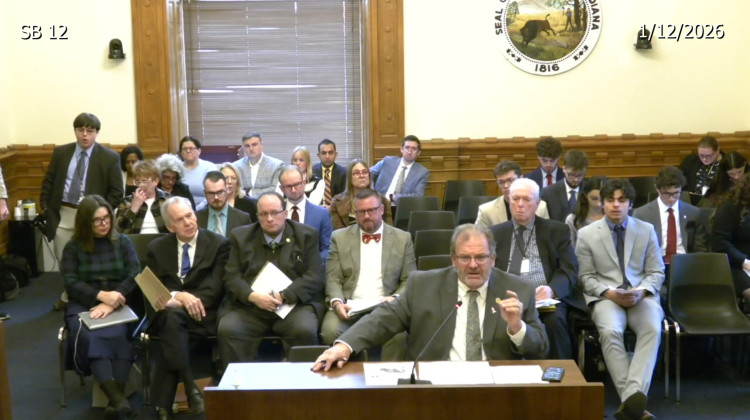
The legislative session is underway, and that means the next few months will be filled with reporting on votes, language and debates over bills moving through the General Assembly.
IPBS-RJCThe legislative session is underway, and that means the next few months will be filled with reporting on votes, language and debates over bills moving through the General Assembly.
Which we know can be … dense.
Of course, following journalists and reading their work is a great way to stay informed about the session, but if you don’t check in every day it can be hard to jump right in.
So how can you stay informed if a story about a bill comes across your Facebook feed or a friend brings up a piece of legislation they heard about?
Here’s our crash course in following legislation through the 2017 session.
How A Bill Becomes A Law In Indiana
First, it’s important to understand the steps every bill takes through the General Assembly, and a lot of that is on its website (here’s instructions on how to use the General Assembly website).
(A) PRE-INTRODUCTION: An idea is developed, and a senator or representative decides to sponsor it. He or she drafts a bill, with research and technical help from the nonpartisan Legislative Services Agency (LSA).
(B) INTRODUCTION: The representative enters the bill into his or her respective chamber. The only exception here is that bills raising revenue can only originate in the House.
(C) CONSIDERATION: This is where the sausage is made. Chamber leadership calls the bill for discussion.
- First reading: The bill is read aloud to the entire chamber and assigned to an appropriate chamber committee for review.
- Committee: The committee chairperson puts the bill up for public hearing, where the full committee hears testimony, discusses merits and pitfalls of the measure, and votes on advancing the bill.
- Second reading: The bill returns to the chamber it came from for discussion before the entire body. Any legislator in that body can suggest amendments to the bill, which have to be approved by a majority vote. After all approved amendments have been added, the chamber votes on the bill as a whole. The chamber may also send the bill back to committee, if they need more information.
- Third reading: The same chamber now schedules the same bill for a third discussion. This is the same process as the second reading, except that any proposed amendments must be approved by a simple majority. The chamber votes on advancing the bill as a whole.
- Opposite chamber: The bill moves to the other legislative chamber (form the Senate to the House or the House to the Senate). It then repeats the same process of consideration (first reading, committee, second reading, third reading).
- Finalizing: The bill returns to the chamber of origin, which must approve or deny any amendments their counterparts added. If approved, the bill moves on to the governor. If denied, the bill goes to a conference committee – a group made up of two members from each chamber, one from each political party. Once they reach agreement, the bill returns to both chambers for approval.
(D) GOVERNOR’S ACTION: The bill is presented to the governor, who has seven days to act. He or she has three options: He can sign the bill, in which case it becomes law; He can do nothing, in which case the bill becomes law without his signature; or, he can veto the bill, in which case it goes back to the House and Senate, who have the opportunity to over-ride the veto with a two-thirds majority vote. If both chambers achieve that majority, the bill becomes law.
You Want To Follow Along?
If there is a particular bill you are interested in (view the entire list of bills filed), here’s how you can track its progress through the process.
We’ll use Senate Bill 30, a bill that would require the Indiana Department of Education to issue reports every semester on students using vouchers.
Head to the General Assembly website and either search the specific bill number (SB30) if you know it, or find it under the Legislation > Bills tab. Choose the bill from this list.
This will take you to the bill’s individual page.
The left hand side is where you can find all the information on the bill you’ll want. It’s full version, any amendment and who voted for it in the two chambers. But if you’re looking to see where it is in the process, click “Bill Details”. This is where the list from above will help guide you to where the bill currently sits.
You Want To Make Your Voice Heard
So you’re following along at home, and decide you have an opinion on a bill. There’s a few things you can do to get involved.
1. Call your legislator. There is a House representative and a Senator that represent you, and you can figure out who those people are by typing your address into this form. Talk to their staff and figure out if you want to leave a message or set up a meeting with your legislator to talk about the issue. Legislators often cite conversations they have with constituents when testifying on a bill, so they do value your input.
2. Follow interest groups. Depending on what type of bills you’re interested in, there is likely some sort of group that is following along day by day. Follow them on Twitter or reach out to see what they are testifying for, and let them know your opinion. Also follow the hashtag on Twitter, #inlegis, to see what is being tweeted about during the session.
3. Testify at a committee. The committee is the group of legislators that decide early on how to amend the bill and if it will move forward. Many of the re-writes happen at this stage, making it the best time to make your voice heard, but getting in front of this group takes a little leg work. First, you must figure out which committee oversees the bill (under “Bill Actions” on the bill’s page). Then you have to closely monitor the committee calendars, which aren’t posted until the week of or before. That calendar is found on the home page.
If you click on the committee name link, it will tell you what bills are being heard that day. If you want to testify, show up (meetings are always held during business hours), and sign up via a form right before the meeting starts. The chair will call your name during public testimony.
CORRECTION: A previous version of this story said amendments made during the third reading of a bill required a two-thirds majority. That was incorrect. It only requires a simple majority.
 DONATE
DONATE





 View More Articles
View More Articles






 Support WFYI. We can't do it without you.
Support WFYI. We can't do it without you.